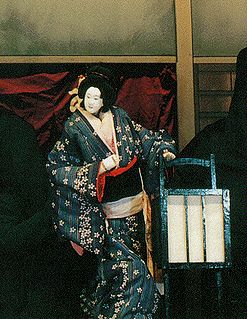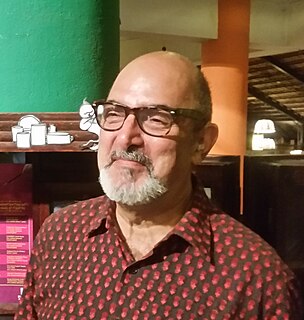
Performing arts refers to forms of art in which artists use their voices, bodies or inanimate objects to convey artistic expression. It is different from visual arts, which is when artists use paint, canvas or various materials to create physical or static art objects. Performing arts include a range of disciplines which are performed in front of a live audience.

A puppeteer is a person who manipulates an inanimate object, called a puppet, to create the illusion that the puppet is alive. The puppet is often shaped like a human, animal, or legendary creature. The puppeteer may be visible to or hidden from the audience. A puppeteer can operate a puppet indirectly by the use of strings, rods, wires, electronics or directly by his or her own hands placed inside the puppet or holding it externally or any other part of the body- such as the legs. Some puppet styles require two or more puppeteers to work together to create a single puppet character.

Puppetry is a form of theatre or performance that involves the manipulation of puppets – inanimate objects, often resembling some type of human or animal figure, that are animated or manipulated by a human called a puppeteer. Such a performance is also known as a puppet production. The script for a puppet production is called a puppet play. Puppeteers use movements from hands and arms to control devices such as rods or strings to move the body, head, limbs, and in some cases the mouth and eyes of the puppet. The puppeteer sometimes speaks in the voice of the character of the puppet, while at other times they perform to a recorded soundtrack.

A marionette is a puppet controlled from above using wires or strings depending on regional variations. A marionette's puppeteer is called a marionettist. Marionettes are operated with the puppeteer hidden or revealed to an audience by using a vertical or horizontal control bar in different forms of theatres or entertainment venues. They have also been used in films and on television. The attachment of the strings varies according to its character or purpose.

Bunraku (文楽), also known as Ningyō jōruri (人形浄瑠璃), is a form of traditional Japanese puppet theatre, founded in Osaka in the beginning of the 17th century. Three kinds of performers take part in a bunraku performance: the Ningyōtsukai or Ningyōzukai (puppeteers), the Tayū (chanters), and shamisen musicians. Occasionally other instruments such as taiko drums will be used.

Avenue Q is a musical comedy featuring puppets and human actors with music and lyrics by Robert Lopez and Jeff Marx and book by Jeff Whitty. The show won Best Musical, Book, and Score at the 2004 Tony Awards. The show was directed by Jason Moore with puppets designed and built by original cast member Rick Lyon. Avenue Q has received many favorable reviews for its approach on themes like racism, homosexuality, and Internet pornography.

Shadow play, also known as shadow puppetry, is an ancient form of storytelling and entertainment which uses flat articulated cut-out figures which are held between a source of light and a translucent screen or scrim. The cut-out shapes of the puppets sometimes include translucent color or other types of detailing. Various effects can be achieved by moving both the puppets and the light source. A talented puppeteer can make the figures appear to walk, dance, fight, nod and laugh.

Traditional Japanese theatre includes kabuki, noh and the puppet theatre, bunraku.

Dadi Pudumjee is a leading puppeteer in India and he is the founder of The Ishara Puppet Theatre Trust. He was awarded the Sangeet Natak Akademi Award in 1992.

Behrouz Gharibpour is an Iranian theatre director and pioneer of traditional Persian puppet theatre.

Theatre of Vietnam comprises many traditional forms of drama which survive and retain their popularity to varying degrees.
Max Jacob was a German puppeteer and the developer of the Hohnsteiner Kasper Theatre in the 1920s.

A puppet is an object, often resembling a human, animal or mythical figure, that is animated or manipulated by a person called a puppeteer. The puppeteer uses movements of their hands, arms, or control devices such as rods or strings to move the body, head, limbs, and in some cases the mouth and eyes of the puppet. The puppeteer often speaks in the voice of the character of the puppet, and then synchronizes the movements of the puppet's mouth with this spoken part. The actions, gestures and spoken parts acted out by the puppeteer with the puppet are typically used in storytelling. Puppetry is a very ancient form of theatre which dates back to the 5th century BC in Ancient Greece. There are many different varieties of puppets, and they are made from a wide range of materials, depending on their form and intended use. They range from very simple in construction and operation to very complex.
The theatre of the Czech Republic has a rich tradition in all genres, including drama, opera, ballet and dance, puppet theatre, black light theatre etc.

The Hessisches Staatstheater Wiesbaden is the State Theatre of the German state Hesse in its capital Wiesbaden, producing operas, plays, ballets, musicals and concerts on four stages. It is also known as Staatstheater Wiesbaden or Theater Wiesbaden, its orchestra is the Hessisches Staatsorchester. The building was inaugurated in 1894.

Martin Kušej is an Austrian theatre and opera director, and current Artistic Director at the Residenz Theatre in Munich. According to German news magazine Focus, Kušej belongs to the ten most important theatre directors who have emerged in the German-speaking world since the millennium. He is considered one of the most important directors working today, acclaimed for his dark and incisive productions.

Water puppetry is a tradition that dates back as far as the 11th century when it originated in the villages of the Red River Delta area of northern Vietnam. Today's Vietnamese water puppetry is a unique variation on the ancient Asian puppet tradition.

Timofey Alexandrovich Kulyabin is a Russian theater and opera director.
The Museu da Marioneta has been located since November 2001 in the Convent of Bernardas in Lisbon, Portugal, establishing itself as the first museum in Portugal entirely dedicated to the interpretation and dissemination of the history of puppetry, covering the history of this art form across the world, presenting the different types of puppets and the different approaches they allow, with special emphasis on Portuguese puppets.















